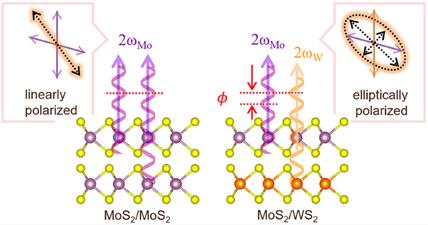
Credit: POSTECH
Since the invention of world’s first laser – the ruby laser – in 1960, the human desire to control light has spread to various industries, including telecommunications, medicine, GPS, optical sensors and optical computers. Recently, a POSTECH research team has taken a step closer to its goal of controlling light by identifying nonlinear optical phenomena occurring in heterobilayers composed of two-dimensional materials.
A nonlinear optical phenomenon refers to the occurrence of light whose intensity is not doubled when optical input intensity becomes doubled, in which the resulting output has different frequencies from original input. This phenomenon is easily understood if you think of electrons and nuclei as spring-connected oscillators. When the spring is moved at a constant cycle, light is generated by the oscillation of electrons and nuclei. If the spring-pulling force is small, only light with the same frequency as the applied external force is formed, but when a strong force is exerted, light with multiple frequency is produced. Among these, light with twice the input frequency is called second-harmonic generation (SHG). The secondary harmonic wave phenomenon can occur in substances that are not point-symmetric, and it has recently been discovered that efficiency is high in 2D semiconductor crystals such as molybdenum disulfide (MoS2) and tungsten disulfide (WS2).
A research team led by Professor Sunmin Ryu and Wontaek Kim in the MS/Ph.D integrated program in the Department of Chemistry at POSTECH noted that the secondary harmonic wave produced by a heterobilayer material (MoS2/WS2) could not be explained by the existing model, and confirmed that it was caused by the SHG interference with different phases. The team anticipated the phase difference in SHG through the results of polarizing spectroscopy of heterolayers that showed the elliptically polarized SHG light. The phase difference directly measured through the secondary harmonic wave interferometer2 was quantitatively consistent with the results obtained from polarizing spectroscopy, proving their hypothesis. In addition, DFT calculations were able to support these results.
So far SHG studies of 2D materials have mostly been limited to its intensity but this is the first time that the SHG phase was measured and it was shown that there is a difference in SHG phase between the two materials. The research showed the possibility of controlling SHG’s phase.
“The conventional research was biased toward identifying the orientation of 2D crystal samples using SHG intensity and controlling it through external stimuli,” remarked Professor Sunmin Ryu who led the study. He added, “This study not only broadened our understanding of nonlinear optical phenomena of 2D materials, but also opened new possibilities for nonlinear spectroscopic control methods.” He concluded, “The research results are expected to greatly contribute to the control of nonlinear optical phenomena by using 2D materials to produce new photons with twice the frequency of vibration and controlled phase.”
###
Published in the latest issue of the prestigious international journal Nano Letters, this research was conducted with the support from the Mid-Career Researcher Program and the Basic Research Lab Program (2D Van der Waals Material Science and Chemical Engineering Lab) of the National Research Foundation of Korea.
Media Contact
Jinyoung Huh
[email protected]
Original Source
http://postech.
Related Journal Article
http://dx.




